If you enjoy creamy vegan soups, sauces, and casseroles, then it's important to know how to make vegan bechamel sauce. This guide shows you how easy it is to make dairy-free bechamel sauce in just under 20 minutes using only 4 ingredients!
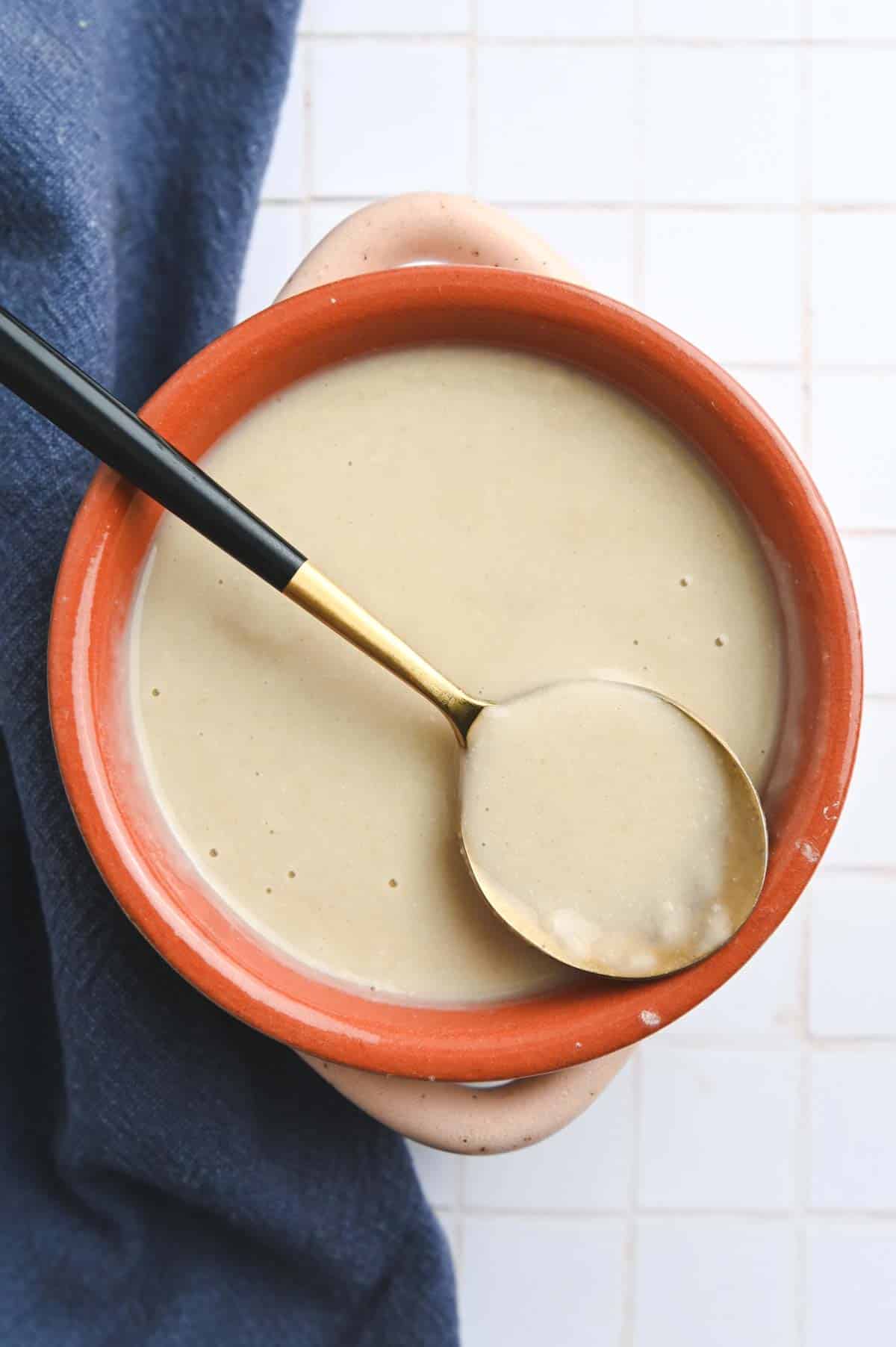
If you like creamy dairy-free sauces, it's worth knowing how to make a vegan bechamel sauce. It is one of five French mother sauces, and it is very easy to make dairy-free and vegan with just a few simple swaps.
Bechamel sauce is simply white sauce, which is made using a white roux and liquid (most commonly milk). Roux is just the French term for equal parts fat and flour, cooked for varying lengths to impart richness and creaminess into sauces.
Knowing how to create a lusciously creamy sauce is a necessary part of dairy-free cooking. Even as a vegetarian, I cook mostly with soy milk and so I make dairy-free bechamel sauce frequently.
While you can use cashews and cashew cream to make creamy vegan sauces, this is a less expensive method and it's a great option for anyone with a nut allergy.
I use this method to thicken vegan sauces so often that it's second nature, but I know that making a roux and bechamel can be intimidating if it's your first time.
I use this base recipe for vegan bechamel in my vegan tater tot green bean casserole, dairy-free alfredo sauce, squash casserole, vegan biscuits and gravy, and so many more recipes.
Jump to:
Let's talk about definitions
If you're new to making bechamel sauce in general, it might seem like I'm trying to give a French lesson. Here is a simple explanation of these common cooking terms:
- Bechamel: A white sauce made using white roux and liquid, most commonly dairy milk.
- Roux: This is a mixture of fat (butter or oil) and flour that is cooked for anywhere from 3-4 minutes to 30+ minutes.
- White roux: This is the type of roux needed to make bechamel. It requires the least amount of cooking at just 2-4 minutes.
Ingredients
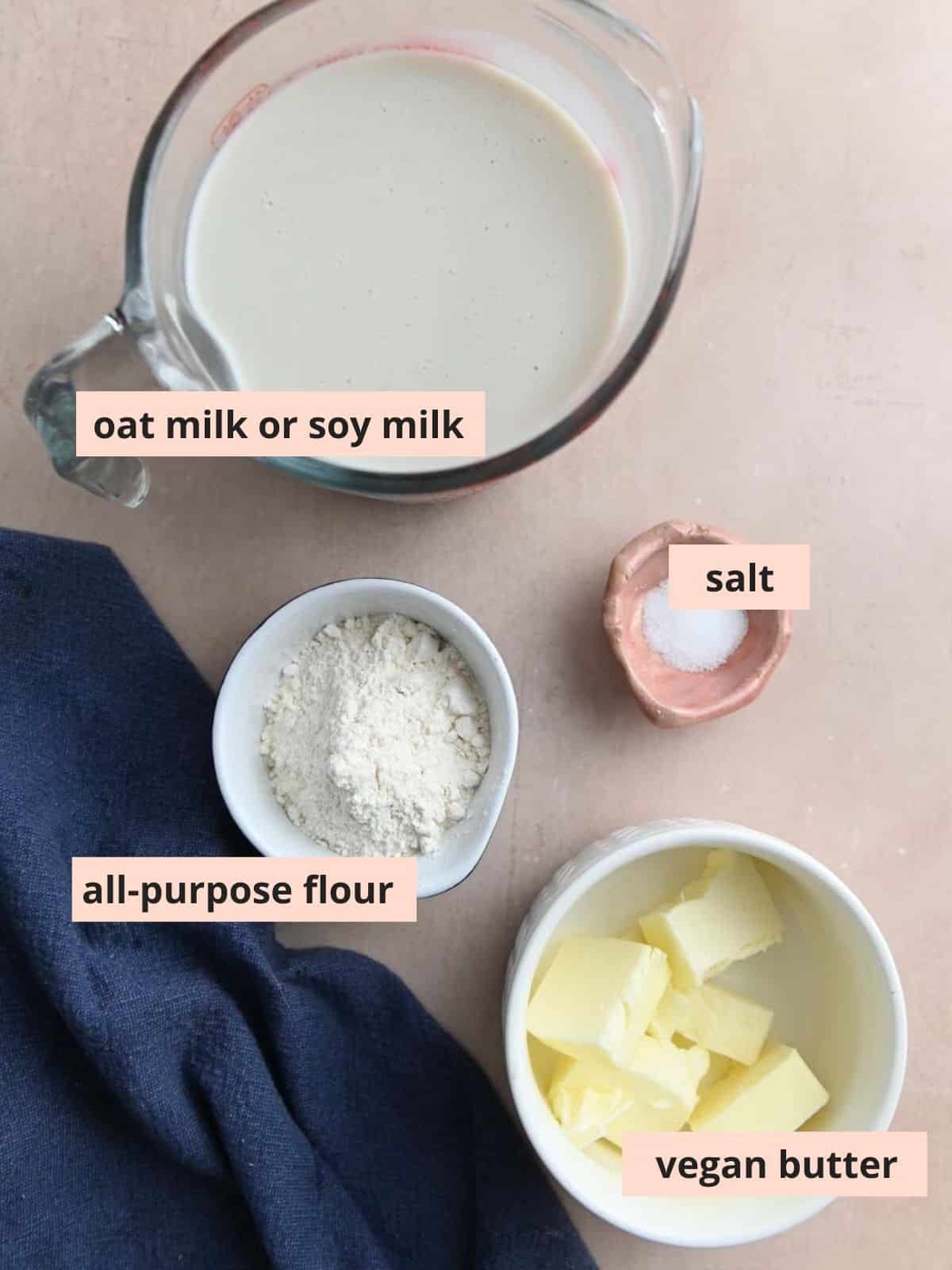
Fat: Oil or butter can be used to make a roux. As you might guess, butter creates a richer sauce while olive oil is a little bit lighter. I've used Earth Balance, Country Crock, and Miyoko's to make vegan bechamel sauce, all with similar results.
Flour: Choose all-purpose flour. You can make a gluten-free vegan roux by using a gluten-free all-purpose flour blend in place of standard flour. I recommend Bob's Red Mill or King Arthur Flour 1:1 gluten-free flour blends. Because these blends don't use standard wheat, cook times may vary slightly.
Liquid: Always choose unsweetened, unflavored non-dairy milk. I use soy milk most frequently, but oat milk also works well and actually creates a richer sauce. Cashew milk also works.
Note that oat and cashew milk have a grayish color that affects the final result, while soy milk stays white. You can use this same method with vegetable broth or water to make gravies.
Tools
Pot or pan: Any type of pot or pan can be used to make a roux. I most frequently use my 12-inch cast iron skillet, but any pan should work. Cast iron skillets hold heat well, so the stove may need to be turned down to medium-low to avoid burning ingredients.
Silicon whisk: This makes toasting the roux and incorporating liquid very easy. I recommend silicon to avoid scratching non-stick pans.
How to make
The roux

Start by heating a large skillet or pot over medium heat. Add butter or oil.

Once hot and melted, sprinkle flour across the top of the butter. Avoid dumping the flour directly into the pan, as this can create a lumpy sauce.
Using a silicon whisk or wooden spoon, stir in a figure-eight motion to toast the flour. Try to stir continually to avoid burning the flour.
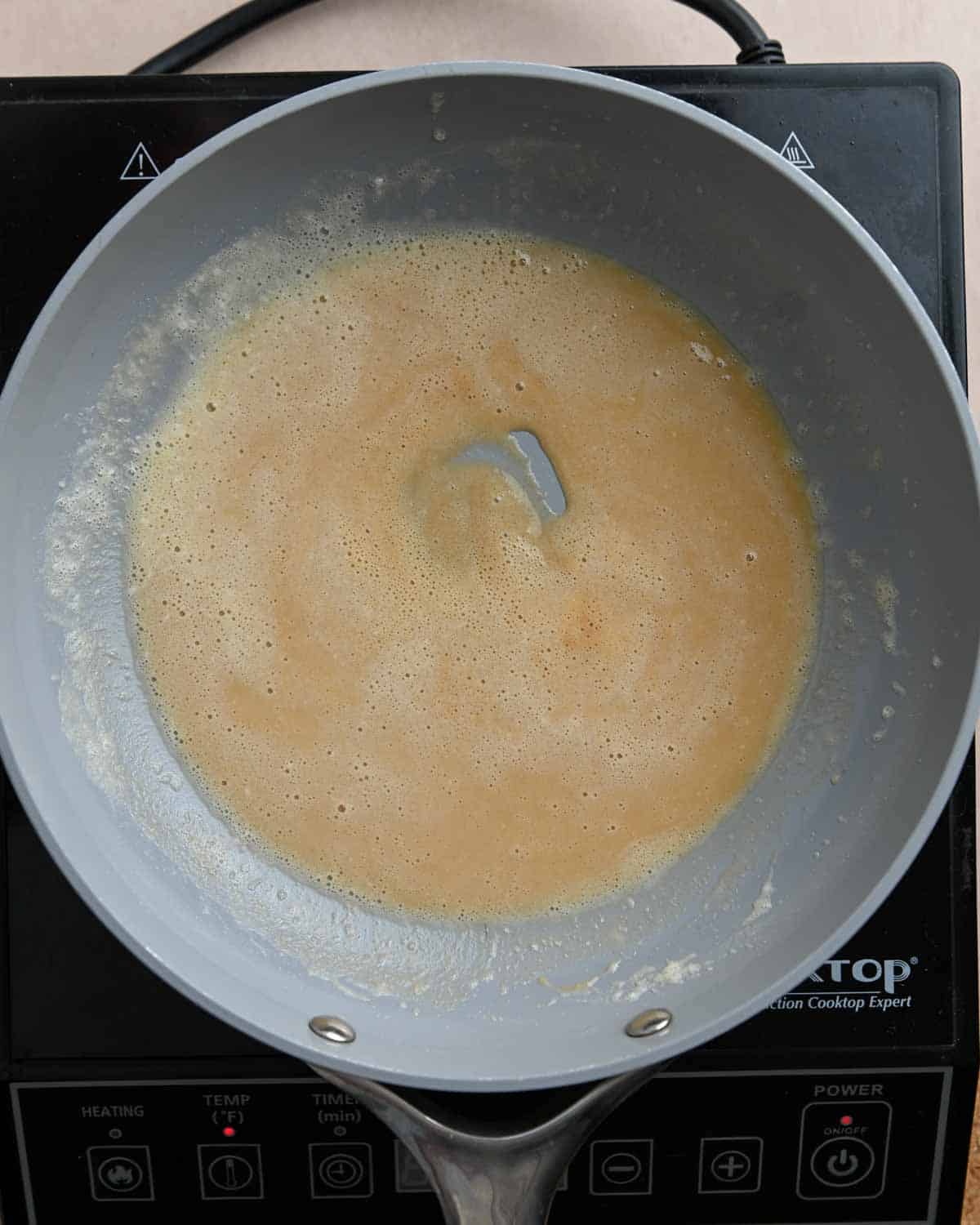
If the butter is browning too quickly, reduce the heat. It will take anywhere from 2 to 4 minutes to toast the flour even to remove the "floury" flavor.
Note: If you continue cooking the roux, it will continue to deepen in color to a brown or dark roux. These are used in Cajun and Creole cooking with gumbo, etc, and can take 30+ minutes to make.
The bechamel sauce

To make the bechamel sauce, start by pouring in just ½ cup of liquid while whisking. This will form a thick paste, which can then be thinned without fear of creating a lumpy sauce.

While whisking, add in the remaining soy or oat milk.
Once all of the liquid is incorporated, the liquid will warm up and start simmering. Reduce heat to medium-low.
The sauce should be bubbling very gently, with just a few bubbles rising to the surface at a time. Reduce heat further if too many bubbles are forming at a time.
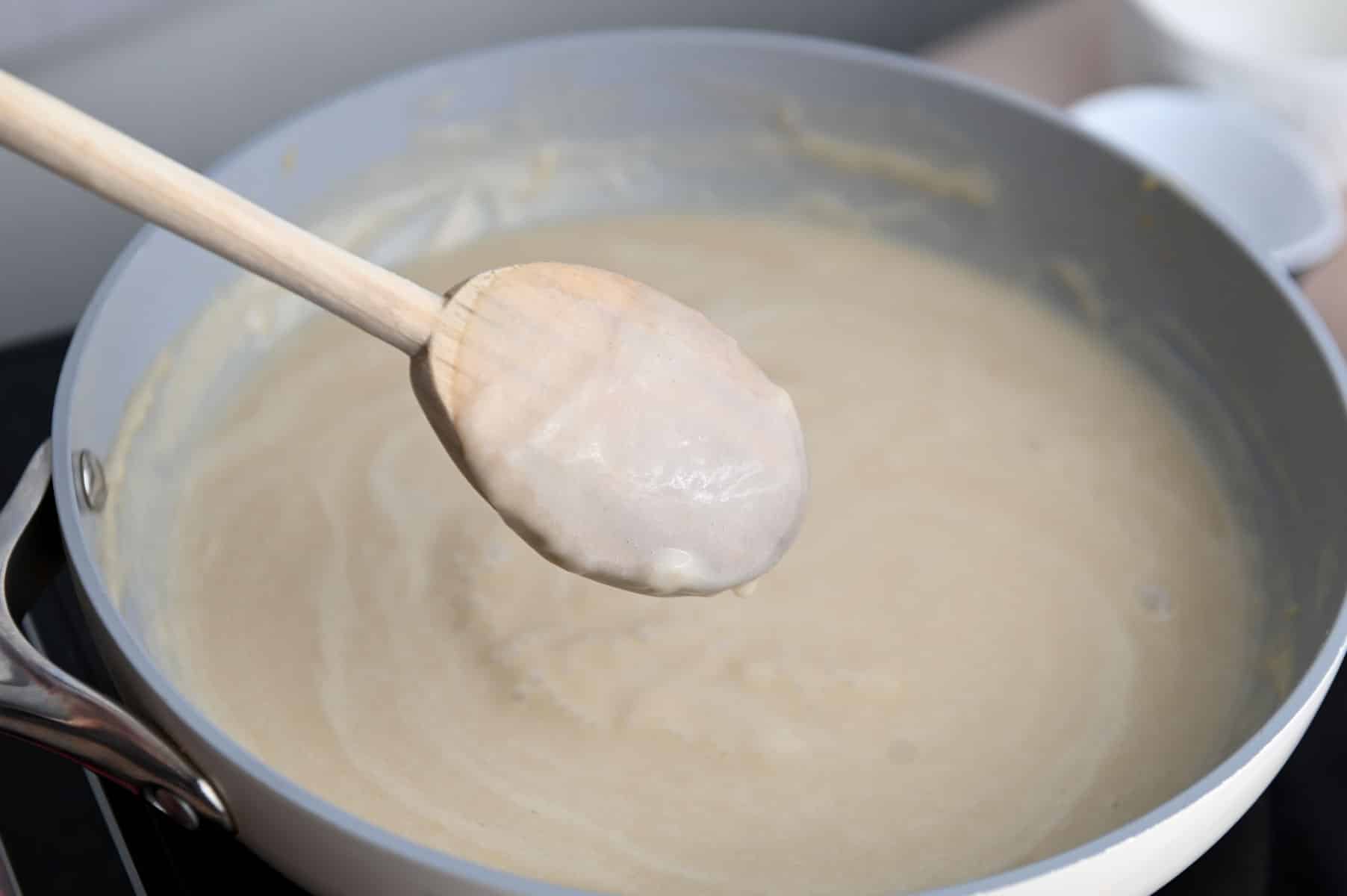
I usually add seasonings like salt and pepper at this point.
Now we wait. The sauce will take at least 6-8 minutes to thicken on medium-low heat. Thickening occurs because of the flour and evaporation of liquid.
Continue stirring every minute or so until the sauce is thick enough to coat the back of a spoon. If left unattended for too long, a skin will form on top of the sauce.
Tips for success
- Use medium heat. Do not crank up the heat. Patience is key when toasting flour and butter for vegan bechamel sauce.
- Toast the flour: This cooks off the raw flour taste and deeps the color of the flour from white to golden. The flour is cooked enough for a white roux when it appears puffy, bubbling, and slightly deepened in color.
- Avoid high heat: High heat not only damages many types of pans, but it can cause non-dairy milk to curdle or separate.
- Keep stirring: Frequent stirring is the most necessary step in creating a smooth, evenly cooked roux. While toasting the flour, stir constantly in a figure-eight motion to avoid burning the flour. Always stir consistently while the liquid is being added.
- Traditionally, it is recommended to let the flour and butter mixture cool slightly before adding liquid. In reality, I never do this and my vegan bechamel ends up perfect (if I may say so myself).
- I start with a smaller amount of liquid (2 cups) because it is easier to thin a thick sauce than it is to thicken a thin one. To thin the sauce, just add ¼ cup milk of choice until the sauce reaches desired consistency.
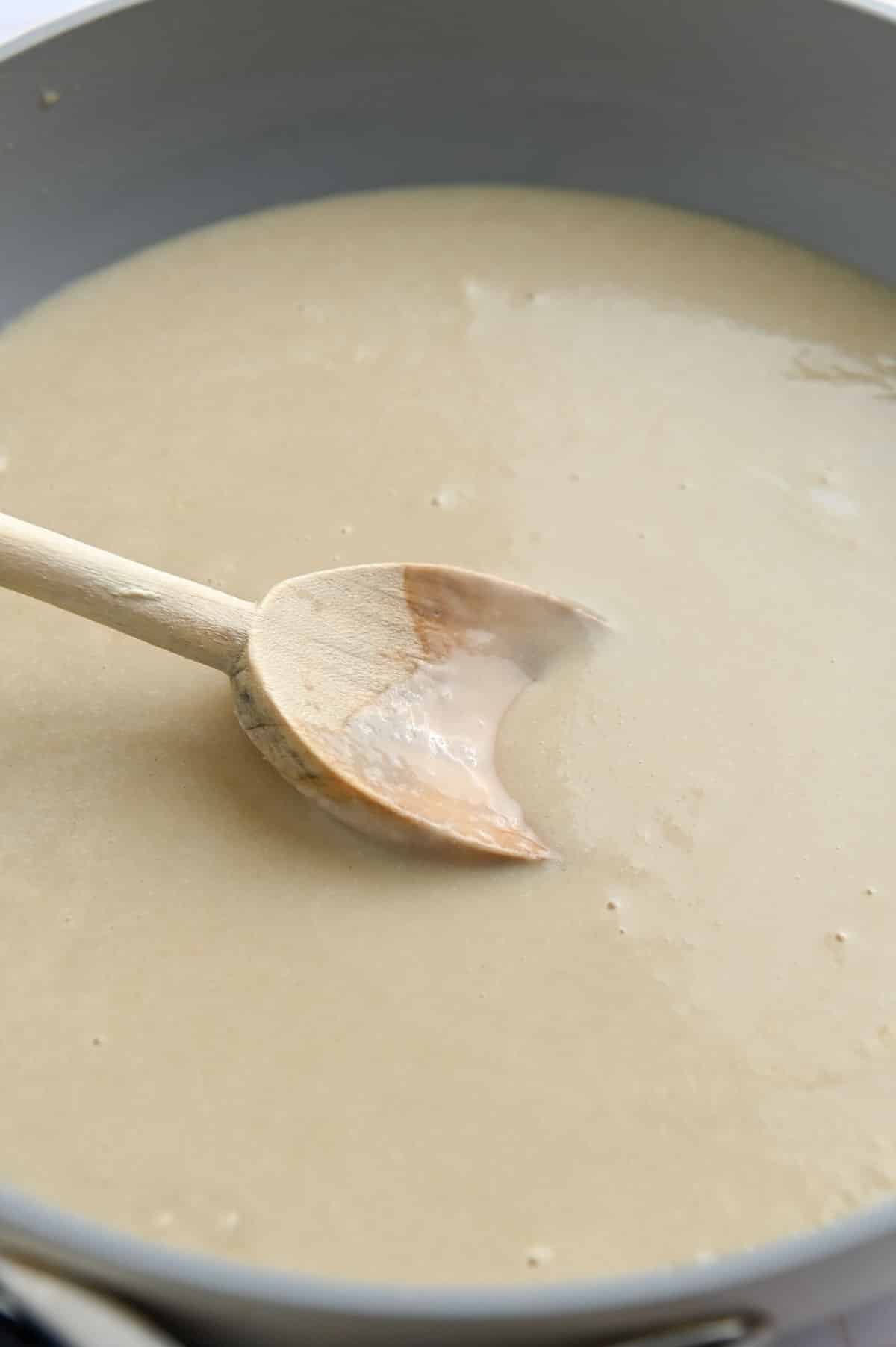
Variations
- Gravy: I use this vegan bechamel sauce as the base for my vegan sausage gravy and I use a similar method for my vegan mushroom gravy and vegan white gravy. Depending on the type of gravy, vegetable broth can be used in place of non-dairy milk.
- Vegan cheese sauce: This is the perfect base for a vegan queso or cheese sauce for vegan mac and cheese. Just add in nutritional yeast or your favorite vegan shredded cheese after the sauce is thickened, then continue heating until melted.
- Garlic sauce: After melting the butter, add minced garlic to taste. Cook until golden, then stir in the flour and continue cooking to achieve a white roux. You can also add garlic powder at the same time as the milk to achieve an even more garlicky sauce.
- Mushrooms and onions: These can be added at the same time as the butter. Cook until softened and golden, then sprinkle in the flour and continue cooking per recipe instructions. I use this method in my tater tot green bean casserole.
Recipe that feature vegan bechamel sauce
I made this guide for you because bechamel sauce and roux are used in Southern US and Midwestern US cooking a lot, and those are the cuisines I pull from most frequently. Naturally, there are a lot of recipes on my blog that feature a vegan roux or bechamel-style sauce.
Did you try this recipe? You can leave a star rating in the recipe card or a review in the comments below. Or check out my new cookbook and keep up to date with my YouTube, Instagram, TikTok, or newsletter!
📖 Recipe
Want to Save This Recipe?
Enter your email & I'll send it to your inbox. Plus, get great new recipes from me every week!
By submitting this form, you consent to receive emails from Cozy Peach Kitchen

How to Make Vegan Béchamel Sauce
Equipment
- medium to large skillet
Ingredients
- ¼ cup vegan butter see note #1
- ¼ cup all-purpose flour
- 2 cups unsweetened soy milk can use oat or cashew milk; see note #2
- ¼ teaspoon salt adjust to taste
Instructions
- Heat a skillet or pot over medium heat. Add butter. Once melted, sprinkle in flour.
- Using a silicon whisk or wooden spoon, stir in a figure-eight motion to toast the flour. If the butter is browning too quickly, reduce the heat. It will take anywhere from 2 to 4 minutes to toast the flour enough to remove the raw flour flavor. It is ready when bubbly and lightly golden.
- While whisking, start by pouring in just ½ cup of non-dairy milk to form a thick paste. Continue whisking while slowly pouring in the remaining liquid.
- When the sauce starts simmering, reduce it to medium-low. The sauce should be bubbling very gently, with just a few bubbles rising to the surface at a time. Reduce heat further if too many bubbles are forming at a time.
- Add salt and any other seasonings at this time. Continue simmering until the sauce is thick enough to coat the back of a spoon without dripping off. This will take 6-8 minutes. If it is taking too long to thicken, bump the heat up a small amount.
- For a thinner sauce, add in ¼ cup milk at a time. For a thicker sauce, continue simmering. Store for up to 3 days in the fridge. Note that the sauce thickens up when cooled.
Video
Notes
- Butter: Any style of vegan butter works. Oils like olive oil or avocado can also be used but will yield a slightly less rich sauce.
- Milk: I prefer using soy milk because it creates a white sauce. Oat milk and cashew milk also work well but tend to create a gray-tinged sauce. This method also works with canned coconut milk.
- Gluten-free option: Use a 1:1 gluten-free flour blend to make this gluten-free. I recommend Bob's Red Mill or King Arthur Flour.
- This recipe is meant to be used as a base recipe. Increase flavor by adding black pepper, herbs, garlic, or other seasonings. For example, this method of cooking is used in my vegan sausage gravy, vegan mushroom gravy (vegetable broth is used in place of milk), and even in one pot pasta recipes.
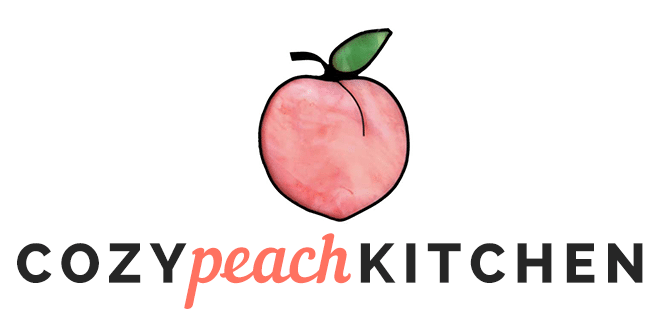



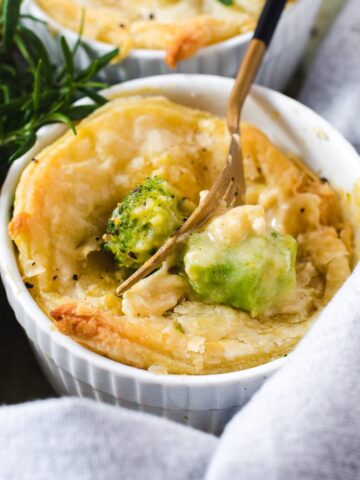

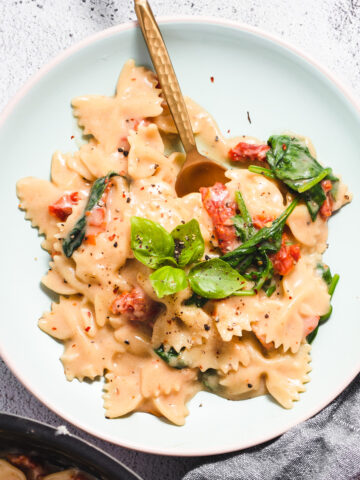
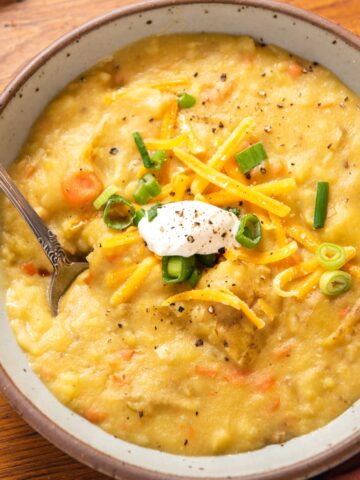
Comments
No Comments